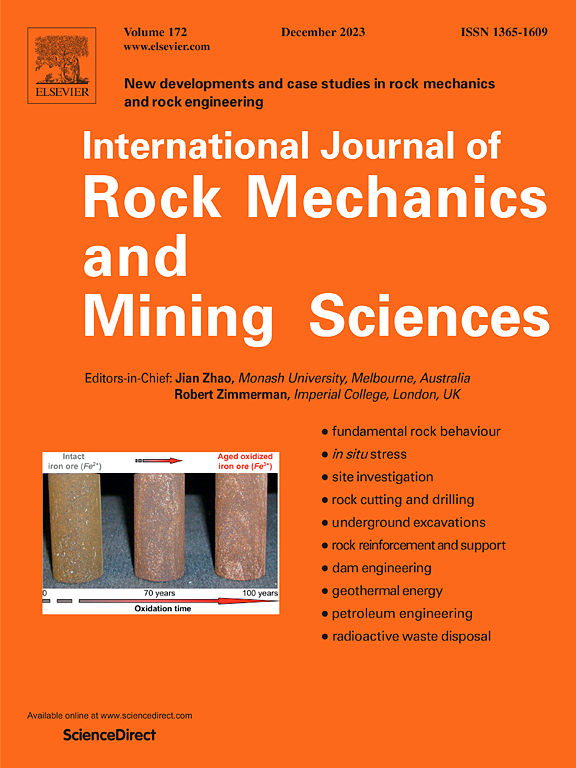Temperature and pressure effects on the mechanical behavior of porous carbonates saturated by viscous fluids
IF 7
1区 工程技术
Q1 ENGINEERING, GEOLOGICAL
International Journal of Rock Mechanics and Mining Sciences
Pub Date : 2024-10-17
DOI:10.1016/j.ijrmms.2024.105938
引用次数: 0
Abstract
Pressure, temperature, and infilling fluids influence the petrophysical properties and the associated damaging processes of rocks at all scales and at all depths. Moreover, each fluid-rock system possesses peculiar mechanical behavior, being this particularly complex in carbonate rocks. We focus on an outcropping carbonate-bearing reservoir (Majella, Central Italy), that represents a very good analogue for buried reservoirs. We performed hydrostatic and triaxial deformation tests up to a temperature of 100 °C and a confining pressure up to 100 MPa on both clean and naturally hydrocarbon-filled samples. Results show increasing seismic velocity and Young's modulus with increasing confining pressures for both clean and saturated samples. However, different results are observed when the temperature is increased. At low temperatures, saturated samples show larger seismic velocity and rigidity with respect to clean samples due to the solid state of the hydrocarbon at ambient conditions, whilst at higher temperatures the opposite occurs. When temperature is raised up to 100 °C the Young's modulus of the saturated samples decreases by ∼25 %, being coupled by a volume reduction of ∼1 cm3 even during hydrostatic tests (no differential stress applied). Accordingly, microstructural observations highlight crackle breccia and grain crushing microstructures with a large number (more than 30/100 μm) of randomly distributed cracks in saturated samples after both hydrostatic and triaxial tests. On the contrary, tested clean samples are characterized by few microfractures (less than 1/μm), pointing out the primary role played by melting hydrocarbons. Thus, the presence of melted hydrocarbons weakens the rock promoting fracturing, whilst at lower temperature the presence of solid hydrocarbons increases the mechanical properties of hydrocarbon-bearing rock. These observations have a large impact on the risk related to mining or porous carbonate reservoirs depletion and for understanding microscale to mesoscale mechanisms of deformation and viscous fluids movement along rock volumes.
温度和压力对粘性流体饱和多孔碳酸盐力学行为的影响
压力、温度和充填流体对岩石的岩石物理特性和相关的破坏过程产生影响,其范围和深度不一而足。此外,每种流体-岩石系统都具有独特的力学行为,在碳酸盐岩中尤为复杂。我们重点研究了一个露头碳酸盐岩储层(意大利中部的马耶拉),它是埋藏储层的一个很好的模拟对象。我们对清洁样本和天然碳氢化合物充填样本进行了水压和三轴变形测试,温度最高达 100 °C,约束压力最高达 100 兆帕。结果表明,清洁样本和饱和样本的地震速度和杨氏模量都随着封闭压力的增加而增加。然而,当温度升高时,观察到的结果却不同。在低温条件下,由于碳氢化合物在环境条件下呈固态,饱和样品的地震速度和刚度比清洁样品大,而在高温条件下则相反。当温度升高到 100 °C 时,饱和样品的杨氏模量下降了 25%,同时体积也缩小了 1 cm3,即使在水压试验中也是如此(没有施加差应力)。因此,微观结构观察结果表明,在水压试验和三轴试验后的饱和样品中,存在大量(超过 30/100 μm)随机分布的裂纹,并出现裂纹角砾岩和晶粒破碎微观结构。相反,经过测试的清洁样品则只有很少的微裂缝(小于 1/μm),这说明碳氢化合物的熔化起了主要作用。因此,熔融碳氢化合物的存在会削弱岩石,促进断裂,而在较低温度下,固态碳氢化合物的存在会增加含碳氢化合物岩石的机械性能。这些观察结果对采矿或多孔碳酸盐岩储层枯竭的相关风险有很大影响,也有助于了解岩石体积变形和粘性流体运动的微观到中观机制。
本文章由计算机程序翻译,如有差异,请以英文原文为准。
求助全文
约1分钟内获得全文
求助全文
来源期刊
CiteScore
14.00
自引率
5.60%
发文量
196
审稿时长
18 weeks
期刊介绍:
The International Journal of Rock Mechanics and Mining Sciences focuses on original research, new developments, site measurements, and case studies within the fields of rock mechanics and rock engineering. Serving as an international platform, it showcases high-quality papers addressing rock mechanics and the application of its principles and techniques in mining and civil engineering projects situated on or within rock masses. These projects encompass a wide range, including slopes, open-pit mines, quarries, shafts, tunnels, caverns, underground mines, metro systems, dams, hydro-electric stations, geothermal energy, petroleum engineering, and radioactive waste disposal. The journal welcomes submissions on various topics, with particular interest in theoretical advancements, analytical and numerical methods, rock testing, site investigation, and case studies.

 求助内容:
求助内容: 应助结果提醒方式:
应助结果提醒方式:


